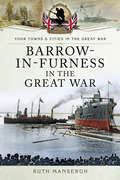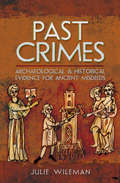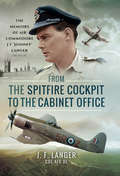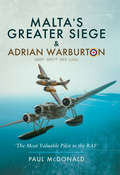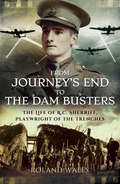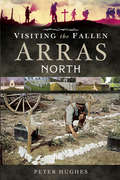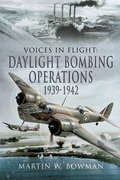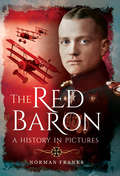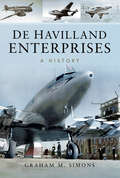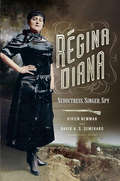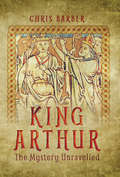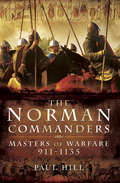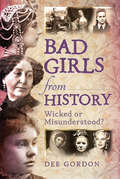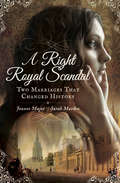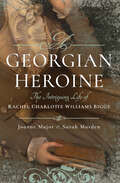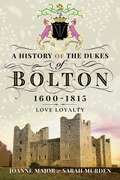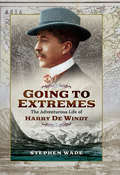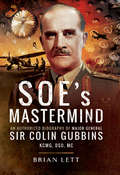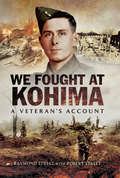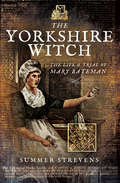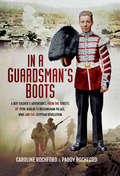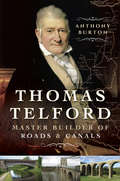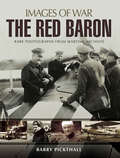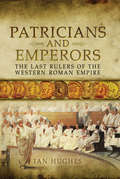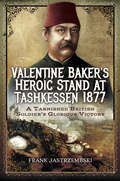- Table View
- List View
Barrow-in-Furness in the Great War (Your Towns & Cities in the Great War)
by Ruth ManserghThis book is about how Barrow's output of war materials was vital to the Great War effort, and it is about the Barrovians and men from the surrounding south Lakeland area - from all walks of life - who fought abroad, and the area's women war heroes. It includes background information on the history of the town, such as the Furness Railway, iron ore in the area and shipbuilding, and lists vessels built at Barrow pre- and during the war with information on what happened to them. These vessels include Mikasa and HMS Vanguard. At the outbreak of World War One, Vanguard fought in the battle of Jutland. The Mayfly (or the Won't Fly as Churchill called it), built by Vickers at Barrow along similar lines to the very early Zeppelins, was launched in 1911. She was the first British rigid airship to be built. Today, Astute submarines for the Royal Navy keep Barrow busy and local people turn up when new submarines are launched. This book also acts as a reference guide to local war dead and war heroes, lost heroes, the area's recipients of the Victoria Cross, memorials with details of those commemorated (including those whose names were unwelcome on memorials). Barrow's War Memorial in Barrow Park was unveiled in November, 1921 by Field Marshall Sir William "Wullie" Robertson and records close to 600 names of those who fought and died in the First World War.
Past Crimes: Archaeological & Historical Evidence for Ancient Misdeeds
by Julie Wileman&“Presents an understanding of the science, skills, and craft of the archaeologist and how these can be used to unravel many criminal mysteries.&” —Police History Society Newsletter Today, police forces all over the world use archaeological techniques to help them solve crimes—and archaeologists are using the same methods to identify and investigate crimes in the past. This book introduces some of those techniques, and explains how they have been used not only to solve modern crimes, but also to investigate past wrongdoing. Past Crimes presents archaeological and historical evidence of crimes from mankind&’s earliest days, as well as evidence of how criminals were judged and punished. Each society has had a different approach to law and order, and these approaches are discussed here with examples ranging from Ancient Egypt to Victorian England—police forces, courts, prisons, and executions have all left their traces in the physical and written records. Also discussed here is how the development of forensic approaches has been used to collect and analyze evidence that were invented by pioneer criminologists. From the murder of a Neanderthal man to bank fraud in the nineteenth century, via ancient laws about religion and morality and the changes in social conditions and attitudes, a wide range of cases are included—some terrible crimes, some amusing anecdotes, and some forms of ancient law-breaking that remain very familiar.
From the Spitfire Cockpit to the Cabinet Office: The Memoirs of Air Commodore J F 'Johnny' Langer CBE AFC DL
by J. F. LangerAir Commodore John Langer's career has been eventful to say the least. During the Second World War he flew gliders in India in preparation for airborne assaults in Burma, one of the most perilous landscapes to pass across during this time. Post-war, he served on a fighter squadron in Germany and in Malaya, where he was recommended for an AFC. Later on, he commanded No 43 (F) Squadron, the famous 'Fighting Cocks', and was awarded the AFC. As a Group Captain, he commanded RAF Valley and was awarded the CBE. He ended his RAF career as director of Flying Training where he set up the first team of the Red Arrows. By careers end, he had flown fifty-six different types of aircraft.On leaving the RAF, he became the Civil Aviation Security Adviser to the UK Government, serving for eight years as a Crown Servant and a further seven years as a consultant. He was a frequent advisor to the Cabinet Office Briefing Room 'A' (Cobra), consulting with members of the cabinet on national and international aviation matters in the wake of a series of security and terrorist emergencies. In 1993 he was appointed Duty Lieutenant for Greater London, with responsibilities for the borough of Hillingdon, location of both Heathrow and Northolt airport. He looked after members of the Royal Family in their departures from these airports and became a good friend of Princess Diana, chaperoning her on a number of solo outings. Interesting details relating to some of their exchanges are included here. This is a unique autobiography, taking in a vast spectrum of events and experiences. It is also an important record of political, aviation and social history and should appeal to enthusiasts of all these areas of interest.
Malta's Greater Siege & Adrian Warburton DSO* DFC** DFC (USA): The Most Valuable Pilot In The Raf
by Paul McDonaldThis is a true historical account of war in the air, at sea and on land in the battle for Malta's survival in the Second World War. It was a battle which decided the outcome of the war in North Africa and the Mediterranean. Adrian Warburton, the airman described in the subtitle by Marshal of the Royal Air Force Lord Tedder, went missing in 1944 in a single-seat American aircraft. He had flown at least 395 operational missions mostly from Malta. Unusually for a reconnaissance pilot, 'Warby' as he was known was credited with nine aircraft shot down. He lay undiscovered for sixty years. He is the RAF's most highly decorated photo-recce pilot.In Malta, Adrian met Christina, a stranded dancer turned aircraft plotter in the secret world deep beneath Valletta's fortress walls. She too was decorated for heroism. Together, they became part of the island's folklore. How important was Malta and the girl from Cheshire to the man behind the medals? This tale takes the form of a quest opening in a cemetery in Bavaria and closing in another in Malta. In between, the reader is immersed within the tension and drama surrounding Malta's Greater Siege retracing the steps of the main characters over the forever changed face of the island following its heroic victory.
From Journey's End to The Dam Busters: The Life of R.C. Sherriff, Playwright of the Trenches
by Roland WalesKingston playwright R.C. Sherriff came to fame with his First World War drama Journeys End, which was based on his own experiences as a young officer on the Western Front. Its success made him a household name and opened the door to a highly lucrative career as a novelist, playwright and screenwriter in Hollywood and in Britain. Many of his movies The Invisible Man, Goodbye Mr Chips, The Four Feathers Odd Man Out, Quartet, and, of course, The Dam Busters are still well known, but the man behind them much less so. This book rediscovers Sherriff using his own words his letters, diaries, published and unpublished manuscripts to shed light on a man who ironically gained his greatest success from the trench warfare he found so difficult to bear.
Visiting the Fallen: Arras: North
by Peter HughesLike Ypres, Arras was a front line town throughout the Great War. From March 1916 it became home to the British Army and it remained so until the Advance to Victory was well under way. In 1917 the Battle of Arras came and went. It occupied barely half a season, but was then largely forgotten; the periods before and after it have been virtually ignored, and yet the Arras sector was always important and holding it was never easy or without incident; death, of course, was never far away. The area around Arras is as rich in Commonwealth War Graves Commission cemeteries as anywhere else on the Western Front, including the Somme and Ypres, and yet these quiet redoubts with their headstones proudly on parade still remain largely unvisited. This book is the story of the men who fell and who are now buried in those cemeteries; and the telling of their story is the telling of what it was like to be a soldier on the Western Front. 'Arras-North' is the first of three books by the same author. This volume contains in depth coverage of almost sixty Commonwealth War Graves Commission cemeteries and is a veritable 'Who's Who' of officers and other ranks who fell on this part of the Western Front. It provides comprehensive details of gallantry awards and citations and describes many minor operations, raids and other actions, as well as the events that took place in April and May 1917. It is the story of warfare on the Western Front as illustrated through the lives of those who fought and died on the battlefields of Arras.There are many unsung heroes and personal tragedies, including a young man who went out into no man's land to rescue his brother, an uncle and nephew killed by the same shell, a suicide in the trenches and a young soldier killed by a random shell whilst celebrating his birthday with his comrades. There is an unexpected connection to Ulster dating back to the days of Oliver Cromwell and William of Orange, a link to Sinn Fein and an assassination, a descendant of Sir Isaac Newton, as well as a conjuror, a friend of P.G. Wodehouse, a young officer said to have been 'thrilled' to lead his platoon into the trenches for the first time, only to be killed three hours later, and a man whose headstone still awaits the addition of his Military Medal after almost a century, despite having been involved in one of the most daring rescues of the war. This is a superb reference guide for anyone visiting Arras and its battlefields.
Daylight Bombing Operations, 1939–1942 (Voices in Flight)
by Martin W. BowmanThere are no records of war more valuable than the first-hand accounts of the individuals who were actually there. The vivid honesty of the stories on display here brings into sharp focus the personal fears as well as the sheer exhilaration of flying sorties by day, often through heavy flak, sometimes at hedge-hopping or wave- skimming heights, as the squadrons of Blenheims, Mosquitoes, Mitchells and Venturas swept across the Continent towards their targets.From the outbreak of the Second World War to the eve of VE Day, the medium bomber crews of 2 Group RAF and 2nd Tactical Air Force flew vital operations over Europe. Here their story is told, month by perilous month, often in the words of the airmen themselves, their accounts supported by meticulous research. Their exploits include the first sorties of the war, the famous Operation Oyster to bomb the Philips works at Eindhoven and other low-level pinpoint attacks against key targets in occupied Europe and Scandinavia. While sharing in the triumph of their bombing successes, we are not spared details of the appalling sacrifices and the failed and aborted raids. These details are relayed in a series of poignant personal snapshots, highlighting the extraordinary valour of these ordinary men. Remarkable photographs include aerial views of targets under attack, as well as dramatic portraits of the aircraft involved. This book serves as a moving tribute to the efforts of the pilots involved in some of the most perilous daylight bombing operations of the Second World War.
The Red Baron: A History in Pictures
by Norman FranksA pictorial history of the infamous German World War I air force pilot, by the author of Dieppe: The Greatest Air Battle. There are numerous books covering the life of Rittmeister Manfred Freiherr von Richthofen, and he has remained at the forefront of World War I studies. In commemoration of one hundred years since the beginning of the war, author Norman Franks introduces a new collection of photographs covering the entire span of von Richthofen&’s war (most of which will have been seen but spread over a variety of literature about First World War flying), consolidated in one book. In the time since the release of Franks earlier titles on a similar theme, a constant trickle of new information has filtered down to him. Although none of it specifically challenges the conclusions drawn in earlier publications, in consolidating them here, he&’s been able to preserve some significant notes of interest. Following several visits to Belgium and Northern France, Franks has managed to acquire additional images, illustrating the places in which the Red Baron lived and fought between 1916 and 1918. This collection covers the entire span of von Richthofen&’s recorded history in pictures, some new and lesser known, some iconic and widely circulated, and all housed here under one roof for the very first time.&“If you are a Red Baron fan, this book is a must-have. Even if you are new to the topic, the text provides an excellent introduction to his career.&” —The Miniatures Page&“In summation, The Red Baron: A History in Pictures is recommended.&” —Over the Front
De Havilland Enterprises: A History
by Graham M. SimonsThis fully illustrated biography examines the life, achievements, and brilliant aircraft designs of one of the great pioneers of powered flight. From his groundbreaking designs during The Great War to the illustrious company that bore his name, Captain Sir Geoffrey de Havilland was one of the most important engineers in the history of aeronautics. Here, Graham Simons charts the course of de Havilland&’s life from his humble beginnings to the influences and milestones of his early years, his versatile warplanes, and the post-war formation of The De Havilland Aircraft Company Limited. Amongst the momentous machines that de Havilland helped develop were the Gipsy Moth and Tiger Moth, two iconic aircraft types destined to set a variety of aviation records while being piloted by de Havilland himself. His high-performance designs and monocoque wooden construction methods passed through the supremely elegant DH.91 Albatross into the Mosquito. Next came the high-performing Hornet fighter, which pioneered the use of metal-wood and metal-metal bonding techniques, eventually resulting in the world&’s first jet airliner, the fabulous Comet. Every one of De Havilland&’s products are recorded here in detail, along with the many designs that never left the drawing board and the products of De Havilland&’s companies in Australia and Canada.
Regina Diana: Seductress, Singer, Spy
by Vivien Newman David A. SemeraroThe Untold Story of Rgina Diana tells of the rebellious daughter of working-class French-Italian parents from a run-down area of Geneva who, trained by the most ruthless spymaster of them all, Elisabeth Schragmller (aka Fraulein Doktor), became a much-adored French caf-concert singer, a discreet and highly prized prostitute plying her trade, and a successful German Great War spy.Reginas spy operations were full of intrigue: a network spanning four countries based in the shamed city of Marseille, with her performing abilities and sexual charms allowing her to lure men from privates to generals into giving her vital information.This book is not just about Rgina, but also explodes the much-vaunted myth of Swiss neutrality. Switzerland, a nest of spies, was riven between support for Germany and France; in an extraordinary penetration of the upper echelons of Swiss society, the Swiss Army Commander-in-Chief was married to former German Chancellor Otto von Bismarks daughter.Yet exhuming Rgina from her unmarked grave involved a tantalizing journey - getting past her disavowal by both France and Switzerland, unraveling the truth behind a three-line report about a pretty Swiss singers execution and overcoming the obfuscation of French military archivists. Even her execution was fittingly exceptional. So determined were the French authorities that she should die, her firing squad numbered not the usual twelve, but twenty-five smoking rifles.
King Arthur: The Mystery Unravelled
by Chris BarberThis book is the culmination of over thirty years of work and research by the author, who is a King Arthur specialist and bestseller.The book brings new information to light by examining through a jigsaw of connections throughout Dark Age Britain, especially Wales and Cornwall, as King Arthur is revealed to have been a hereditary King of the ancient land of the Silures in South Wales. In this way, Chris Barber has set out to reveal the true identity of King Arthur, whose identity has been obscured by the mists of time and the imaginative embellishments of romantic writers through the ages. After sorting fact from fiction, he not only identifies the Celtic prince who gave rise to the legend of Arthur, but reveals his family background, 6th century inscribed stones bearing his name and those of his contemporaries; locations of his courts, battle sites such as Badon Llongborth and Camlann; the identity of his enemies, the ancient Isle of Avalon and his final resting place.
The Norman Commanders: Masters of Warfare, 911–1135
by Paul HillThis illustrated history sheds light on the greatest commanders of medieval Norman warfare, covering all their conquests from France to the Near East. Robert Guiscard, William the Conqueror, Roger I of Sicily, and Bohemond Prince of Antioch are just four of the exceptional Norman commanders who led their armies to victory and created their own kingdoms. Their single-minded leadership, and the skill and discipline of their armies, made them nearly unstoppable in their time. In this volume, Paul Hill studies their brilliant careers—along with those of Robert Curthose, William Rufus, Richard I of Capua and Henry I of England. In a narrative packed with detail and insight, and with a wide-ranging understanding of the fighting methods and military ethos of the period, Hill traces the course of their conquests, focusing on their leadership and achievements on the battlefield. The military context of their campaigns, and the conditions of warfare in France and England, in southern Italy and Sicily, and in the Near East, are vividly described. Among the operations and sieges covered in detail are Hastings, Bremule, Tinchebrai, Civitate, Misilmeri, Dyrrhachium, and Antioch. Paul Hill&’s accessible and authoritative account offers a fascinating portrait of these historic conflicts and the commanders who fought them.
Bad Girls from History: Wicked or Misunderstood?
by Dee GordonThis &“lively&” study of female lawbreakers across centuries and cultures is &“chock full of disquieting stories and truly twisted personalities&” (Booklist). Organized A-to-Z under six categories, this book offers insight into the lives and minds of women in different centuries and different countries, with diverse cultures and backgrounds from the poverty-stricken to royalty, who have defied law and order and social taboos. Read about mistresses, murderers, smugglers, pirates, prostitutes, and fanatics with hearts and souls that feature every shade of black (and gray!). From Cleopatra to Ruth Ellis, from Boudicca to Bonnie Parker, from Lady Caroline Lamb to Moll Cutpurse, from Jezebel to Ava Gardner—as well as less familiar names like Victorian brothel-keeper Mary Jeffries, American gambler and horse thief Belle Starr, and La Voisin, the seventeenth-century Queen of all Witches in France—you&’ll find a variety of women from the daring and outrageous to the desperate to the downright evil. Wicked? Misunderstood? Naïve? Foolish? Predatory? Manipulative? Or just rebellious? Read their stories and decide. &“[A] rollicking survey of 100 female renegades . . . this compendium of historical trivia is a lot of fun to read.&” —Publishers Weekly Includes photos and illustrations
A Right Royal Scandal: Two Marriages That Changed History
by Joanne Major Sarah MurdenFrom the authors of An Infamous Mistress: &“The tale of two juicy 19th-century scandals, both concerning the aristocratic Cavendish-Bentinck family&” (Cheshire Life). Almost two books in one, A Right Royal Scandal recounts the fascinating history of the irregular love matches contracted by two successive generations of the Cavendish-Bentinck family, ancestors of the British royal family. The first part of this intriguing book looks at the scandal that erupted in Regency London, just months after the Battle of Waterloo, when the widowed Lord Charles Bentinck eloped with the Duke of Wellington&’s married niece. Over two decades later and while at Oxford University, Lord Charles&’ eldest son fell in love with a beautiful Romany girl, and secretly married her. When his alliance was discovered, he was cast adrift by his family—with devastating consequences. A love story as well as a brilliantly researched historical biography, this is a continuation of Joanne Major and Sarah Murden&’s first biography, An Infamous Mistress, about the eighteenth-century courtesan Grace Dalrymple Elliott, whose daughter was the first wife of Lord Charles Bentinck. The book ends by showing how, if not for a young gypsy and her tragic life, the British monarchy would look very different today. &“An easy read of a subject that keeps you engrossed from start to finish. This book is brilliant for those who enjoy the scandals of historical television, with the added authenticity of historical fact.&” —History of Royals &“The plots may seem to come straight out of the world of Regency Romance but they are all true, and carefully annotated and verified by Major and Murden.&” —Naomi Clifford, author of The Murder of Mary Ashford
A Georgian Heroine: The Intriguing Life of Rachel Charlotte Williams Biggs
by Joanne Major Sarah Murden&“A very fair and balanced portrait of one of the Regency era&’s most remarkable—and most unknown—women&” from the authors of A Right Royal Scandal (Jacqueline Reiter, author of Earl of Shadows). Rachel Charlotte Williams Biggs lived an incredible life, one which proved that fact is often much stranger than fiction. As a young woman she endured a tortured existence at the hands of a male tormentor, but emerged from that to reinvent herself as a playwright and author; a political pamphleteer and a spy, working for the British Government; and later single-handedly organizing George III&’s jubilee celebrations. Trapped in France during the revolutionary years of 1792–95, she published an anonymous account of her adventures. However, was everything as it seemed? The extraordinary Mrs. Biggs lived life upon her own terms in an age when it was a man&’s world, using politicians as her mouthpiece in the Houses of Parliament and corresponding with the greatest men of the day. Throughout it all though, she held on to the ideal of her one youthful true love, a man who abandoned her to her fate and spent his entire adult life in India. In A Georgian Heroine, we delve into Mrs. Biggs&’ life to reveal her accomplishments and lay bare her continued reinvention of herself. This is the bizarre but true story of an astounding woman persevering in a man&’s world. &“Reading the first few pages of this absorbing biography, it is hard to believe that the authors haven&’t concocted a wild historical spoof, for this is truly an amazing story.&” —Jane Austen&’s Regency World
A History of the Dukes of Bolton, 1600–1815: Love Loyalty
by Joanne Major Sarah MurdenA first-ever account of one of the United Kingdom’s foremost ducal families and a history of the times in which they lived.Discover over two hundred years of fascinating history relating to one of Great Britain’s foremost aristocratic dynasties, the (Orde-) Powletts, for several generations the Dukes of Bolton. The family motto, Love Loyalty, references their devotion to the monarchy, but it applies equally to their hearts. Willing to risk all in the pursuit of love, this is the previously untold story of the Dukes of Bolton and their ancestors—the men and women who shaped the dynasty, their romances, triumphs, foibles, and tragedies.
Going to Extremes: The Adventurous Life of Harry de Windt
by Stephen WadeHarry de Windt (1856–1933) was a man who, by any standards, was a personality, a marked presence in the world of Victorian and Edwardian literature and social life. He was a member of the literary circle around Oscar Wilde and his friend and lover, Bosie (Lord Alfred Douglas); he was active in the world of the turf; and he travelled he took on dangerous journeys with relish, crossing vast tracts of the British and Russian empires for the sheer thrill of it. This book traces his life and adventures, at home and abroad, and also gives an account of his early work on military service in Sarawak, Malaysia, his expert knowledge of the Russian prison system, and his later Great War role running a POW camp. Many of his books reflect epic journeys against the odds: From Paris to New York by Land, Savage Europe, Siberia As It Is and others. His autobiographical work, My Restless Life, perhaps sums up his nature.Interesting facts: * Harry de Windt was brother to the Ranee of Sarawak and fought against rebels there in his early career * He visited the penal colony on the Russian island of Sakhalin close to the same time that Anton Chekhov went there * He appeared as a witness in the trial for libel of Lord Alfred Douglas, as he blamed Winston Churchill for the heavy losses in the Battle of Jutland * On his travels he met a host of interesting people from murderers to statesmen
SOE's Mastermind: The Authorised Biography of Major General Sir Colin Gubbins KCMG, DSO, MC
by Brian LettThe first complete biography of Britain&’s WWII spymaster presents an intimate look at his life and career, as well as an insider&’s look at the SOE. Major General Sir Colin Gubbins was the driving force behind Britain&’s Special Operations Executive, the secret military organization established by Winston Churchill in 1940. First as its Operations and Training Director, and then its Commander, Gubbins orchestrated every aspect of the SOE&’s worldwide covert operations. Though Gubbins made enormous contributions to Allied victory, his life and work have remained shrouded in secrecy until now. With copious research and unprecedented access to family archives, biographer Brian Lett reveals the war hero&’s early experiences in the Great War, as well as in Russia, Ireland, Poland, and as Head of British Resistance. The result is a fascinating biography that reveals as much about SOEs extraordinary activities as it does about the man who inspired and commanded them.
We Fought at Kohima: At Veteran's Account
by Robert Street Raymond StreetThe Japanese advance through Thailand, Malaya and Burma appeared unstoppable and the fate of India looked utterly precarious.The garrison of the Kohima outpost numbering some 1500 British and Indian Army soldiers faced over 13,000 fanatical and previously victorious Japanese troops. The following sixteen days marked the turning point of the war in the Far East thanks to men like Raymond Street who fought with legendary courage and tireless persistence.Raymond was a member of the 4th Battalion The Queen's West Kent and as a company runner he was uniquely placed to witness the dreadful and dramatic events as they unfolded. Not only did he miraculously survive but he made a superb record of the battle as fortunes ebbed and flowed. His memories have been transcribed into this first-hand account of one of the most decisive and hardest fought battles of the Second World War. We Fought at Kohima will surely be judged as a fighting man's memoir of the highest quality to rank alongside such legendary works as Men at Arnhem and Quartered Safe Out Here.
The Yorkshire Witch: The Life And Trial Of Mary Bateman
by Summer StrevensOn the morning of 20 March 1809, the woman who had earned herself the title of ‘The Yorkshire Witch’ was hanged upon York’s ‘New Drop’ gallows before an estimated crowd of 20,000 people. <p><p> Some of those who came to see Mary Bateman die had traveled all the way from Leeds, many of them on foot, and many of them were doubtless the victims of her hoaxes and extortion. <p> A consummate con-artist, Mary was extremely adept at identifying the psychological weaknesses of the desperate and poor who populated the growing industrial metropolis of Leeds at the turn of the nineteenth century. Exploiting their fears and terror of witchcraft, Mary Bateman was well placed to rob them of all their worldly goods, yet she did much more than cause misery and penury; though tried and convicted on a single murder charge, the contemporary branding of Bateman as a serial killer is doubtless accurate. <p> Meticulously researched, this accessible, and at times shocking retelling of Mary Bateman’s life, and indeed her death, is the first since the publication chronicling her criminal career appeared in print in 1811, two years after her execution. Not only focusing on the details of her felonies and the consequences to her victims, it also examines the macabre legacy of her mortal remains, a bone of contention (literally you might say!) with the continuous public display of her skeleton in the Thackray Medical Museum until the recent removal of this controversial exhibit.
In a Guardsmans Boots: A Boy Soldiers Adventures from the Streets of 1920s Dublin to Buckingham Palace, WWII and the Egyptian Revolution
by Caroline Rochford Paddy RochfordWhen he was just eight years old, Paddy Rochford enrolled at Dublins Royal Hibernian Military School, where he was taught how to be a soldier with the British Army, like his father. Soon afterwards, in 1922, he and his fellow pupils were evacuated from Ireland, a land torn apart by civil war. Across the sea in England, Paddy joined the Third Battalion of the Coldstream Guards as a drummer boy, with postings to Windsor Castle, Buckingham Palace, the Bank of England and the Tower of London, where he guarded the Royal Family and Britains treasures. In the 1930s, as thousands of Jewish families fled Nazi Germany, Paddy was sent to Jerusalem, charged with keeping the peace between the local Arabs and the Jewish immigrants. During the Second World War, he was part of the Western Desert Campaign in Egypt, defending British territories. After countless wartime adventures, the young sergeant went on to train the Egyptian Army, where a bond of friendship grew between him and the future president, Colonel Nasser. Learning Nassers plans to oust the British from Egypt, Paddy tried in vain to warn his superiors prior to the bloody revolution of 1952, which signalled the end of British supremacy in the Middle East. Paddy retired from the army soon afterwards, moving his young family to Yorkshire, where he began writing these, his enthralling memoirs about a young boy who spent a lifetime growing into his boots.
Thomas Telford: Master Builder of Roads & Canals
by Anthony BurtonThomas Telford's life was extraordinary: born in the Lowlands of Scotland, where his father worked as a shepherd, he ended his days as the most revered engineer in the world, known punningly as The Colossus of Roads. He was responsible for some of the great works of the age, such as the suspension bridge across the Menai Straits and the mighty Pontcysyllte aqueduct. He built some of the best roads seen in Britain since the days of the Romans and constructed the great Caledonian Canal, designed to take ships across Scotland from coast to coast. He did as much as anyone to turn engineering into a profession and was the first President of the newly formed Institution of Civil Engineers. All this was achieved by a man who started work as a boy apprentice to a stonemason. rn He was always intensely proud of his homeland and was to be in charge of an immense programme of reconstruction for the Highlands that included building everything from roads to harbours and even designing churches. He was unquestionably one of Britain's finest engineers, able to take his place alongside giants such as Brunel. He was also a man of culture, even though he had only a rudimentary education. As a mason in his early days he had worked alongside some of the greatest architects of the day, such as William Chambers and Robert Adams, and when he was appointed County Surveyor for Shropshire early in his career, he had the opportunity to practice those skills himself, designing two imposing churches in the county and overseeing the renovation of Shrewsbury Castle. Even as a boy, he had developed a love of literature and throughout his life wrote poetry and became a close friend of the Poet Laureate, Robert Southey. He was a man of many talents, who rose to the very top of his profession but never forgot his roots: he kept his old masons' tools with him to the end of his days. rn There are few official monuments to this great man, but he has no need of them: the true monuments are the structures that he left behind that speak of a man who brought about a revolution in transport and civil engineering.
The Red Baron (Images of War)
by Barry Pickthall“[A] look at the life of Manfred Von Richthofen . . . The book is built from a collection of negatives and prints the author bought at a book fair.” —War History OnlineBeginning his wartime career on the Western Front in August 1916, Manfred von Richthofen, or the Red Baron as he became known, had shot down an impressive total of fifteen aircraft by January 1917, as well as being appointed commander of his own unit. By the time of his death in 1918, he had destroyed a staggering total of eighty allied aircraft. From the perspective of the allies, he was a deadly menace. For the Germans, he was a fighter pilot hero of legendary significance. This fascinating collection of rare images offers a fresh perspective on the Baron himself, as well as a number of his adversaries from the Allied side of the line.Found by chance at a car boot sale by the author, an esteemed journalist and keen amateur aviator, this collection has sat, mostly unused, for almost a century. Until now. This intriguing addition to the Images of War series is set to ignite new discussions about this most legendary of fighter aces since we passed the centenary of his death, and the ending of the First World War, in 2018.
Patricians and Emperors: The Last Rulers of the Western Roman Empire
by Ian HughesPatricians and Emperors offers concise comparative biographies of the individuals who wielded power in the final decades of the Western Roman Empire, from the assassination of Aetius in 454 to the death of Julius Nepos in 480. The book is divided into four parts. The first sets the background to the period, including brief histories of Stilicho (395-408) and Aetius (425-454), explaining the nature of the empire and the reasons for its decline. The second details the lives of Ricimer (455-472) and his great rival Marcellinus (455-468) by focusing on the stories of the numerous emperors that Ricimer raised and deposed. The third deals with the Patricians Gundobad (472-3) and Orestes (475-6), as well as explaining how the barbarian general Odoacer came to power in 476. The final part outlines and analyses the Fall of the West and the rise of barbarian kingdoms in France, Spain and Italy.This is a very welcome book to anyone seeking to make sense of this chaotic, but crucial period.
Valentine Baker's Heroic Stand at Tashkessen 1877: A Tarnished British Soldier's Glorious Victory
by Frank JastrzembskiThere are moments in the past of many a man's career that stand out clear and defined after the lapse of even many years: life pictures, the very memory of which brings back a glorious thrill of pride and pleasure. This is the feeling which vibrates through me still, when I recall that last and closing scene that crowned the hard-fought fight at Tashkessen.History has best remembered Valentine Baker for his embarrassments. In 1875, he was accused of sexual assault and dismissed from the British Army. In 1884, he suffered an embarrassing defeat at the Battle of El Teb. But what about Baker's positive achievements?The most underappreciated event that took place in his controversial life came during the Russo-Turkish War in 1877. The exiled Baker, in command of 3,000 Ottoman soldiers, was dispatched to the village of Tashkessen to stall 25,000 advancing Russian soldiers. Through his superb leadership and brilliant disposition of his troops, Baker was able to score a victory.The Spartan stand of Baker and his command has gained little recognition. Despite this modern obscurity, Baker's performance at Tashkessen was applauded by his contemporaries as a model of tactical leadership and heroism. This is the exhilarating tale of how Valentine Baker was able to find redemption at Tashkessen.
